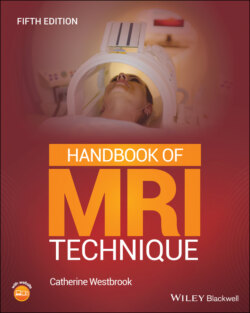Читать книгу Handbook of MRI Technique - Catherine Westbrook - Страница 34
SCAN TIME
ОглавлениеThe scan time is the time required to complete the acquisition. The scan time can be decreased by using:
a short TR
a coarse phase matrix
the lowest NEX/NSA possible.
In addition to the SNR, CNR, spatial resolution and scan time, the following imaging options are also described under the Technical issues subheading:
Rectangular FOV: The use of rectangular FOV is often discussed in Part 2. It enables the acquisition of fine matrices but in scan times associated with coarse matrices. It is most useful when anatomy fits into the shape of a rectangle, for example a sagittal spine. The long axis of the rectangle usually corresponds to the frequency encoding axis and the shorter axis to phase encoding. This is important as certain phase artefacts, such as phase ghosting and aliasing, occur along the short axis of the rectangle. The dimension of the phase axis is usually expressed as a proportion or percentage of the frequency axis, for example 75%. On some systems, rectangular FOV and oversampling are not compatible. If this is so, signal‐producing anatomy existing beyond the FOV along the shorter phase axis is wrapped into the image. This is reduced by increasing the FOV, using spatial pre‐saturation bands to nullify unwanted signal or by expanding the short axis dimension to incorporate all signal‐producing anatomy (see Flow phenomena and artefacts).
Radial k‐space: Radial k‐space is a non‐Cartesian k‐space filling method. Data are not laid out in lines, but k‐space is filled in strips of data that rotate around the centre point of k‐space. The main advantage of this technique is that as data in the centre of k‐space are averaged every TR, motion artefact is significantly reduced. This technique is therefore often used when motion artefact is likely to be a problem. However, scan times may increase.
Centric k‐space: Centric k‐space fills the centre lines of k‐space first and then the outer lines. This ensures that signal and contrast are optimized as data are collected before the signal decays. This technique is mainly used in fast GRE pulse sequences.
Volume imaging: Volume imaging or 3D acquisitions collect data from an imaging volume or slab rather than from individual slices. An extra phase encoding is undertaken along the slice‐select axis. This is called slice encoding. Very thin slices with no gap are obtained and the data set may be viewed in any plane. However, the scan time in volume imaging depends not only on the TR, the phase matrix and the NEX/NSA but also on the number of slice locations in the volume. Therefore, scan times are considerably longer than in 2D imaging. For this reason, fast pulse sequences such as steady‐state sequences and FSE/TSE are commonly used (see Pulse sequences). To maintain spatial resolution in all viewing planes, the voxels should be isotropic, that is, they have the same dimensions in all three planes. This is achieved by selecting an even matrix and a slice thickness equal to, or less than, the pixel size. For example, if a matrix size of 256×256 is chosen and the FOV is 256 mm, a slice thickness of 1 mm achieves a voxel measuring 1 mm × 1 mm × 1 mm. With a larger FOV, a slightly thicker slice can be used. The penalty of isotropic voxels, however, is a reduction in SNR due to the use of smaller voxels. In addition, more slices may be required to cover the imaging volume, resulting in long scan times. This is compensated for to some degree by the fact that as there are no gaps, a greater volume of tissue is excited and therefore overall signal return is greater. Nevertheless, when volume imaging is used, the need for good spatial resolution in all planes must be weighed against longer scan times.As slices are not individually excited as in conventional acquisitions, but are located by an extra phase encoding gradient, aliasing along the slice select axis can occur. This originates from anatomy that lies within the coil (and therefore produces signal) and exists outside the volume along the slice encoding axis. It manifests itself by the first and last few slices of the imaging volume wrapping into each other and potentially obscuring important anatomy. To avoid this, always overprescribe the volume slab so that the region of interest (ROI) and some anatomy on either side of it are included (see Flow phenomena and artefacts). Volume imaging is commonly used in the brain and to examine joint anatomy, especially when very thin slices are required. In Part 2, the following terms and approximate parameters are suggested when discussing volume imaging (see also Table 2.1):
A thin slice is 1 mm or less.
A thick slice is more than 3 mm.
A small number of slice locations is approximately 32.
A medium number of slice locations is approximately 64.
A large number of slice locations is approximately 128 or more.
